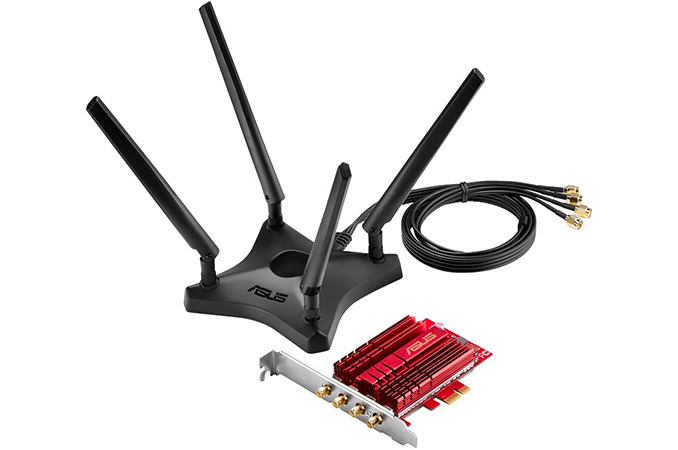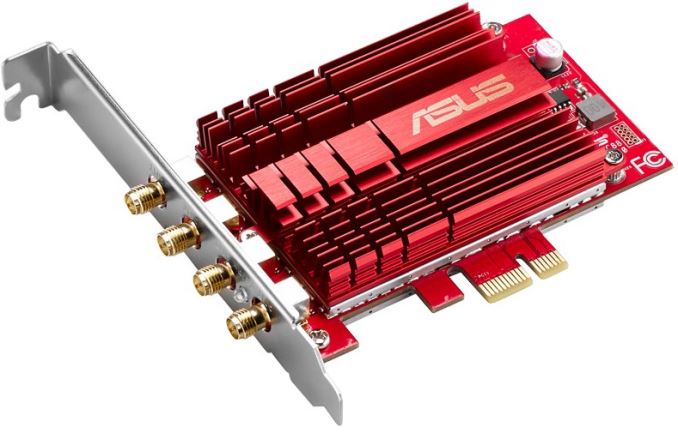ASUS Unveils PCE-AC88 4x4 Wi-Fi Card with 2167 Mbps Bandwidth
by Anton Shilov on May 11, 2016 11:00 AM EST- Posted in
- Networking
- Asus
- Broadcom
- 802.11ac
- PCIe x1

ASUS has introduced its flagship dual-band AC3100 wireless PCIe x1 adapter with four antennas and a maximum supported throughput of 2167 Mbps (270 MB/s). The card is powered by Broadcom’s flagship 802.11ac Wave 2 system-on-chip for Wi-Fi adapters and to show its best, it has to be connected to a router featuring another high-end Broadcom SoC.
The ASUS dual-band AC3100 wireless (PCE-AC88) PCIe adapter is based on the Broadcom BCM4366 SoC introduced early last year. The BCM4366 supports 4x4 802.11ac MU-MIMO technology and can thus use four 802.11n (2.4 GHz/5 GHz) or four 802.11ac (5 GHz) streams. The PCE-AC88 is a small half-height card that features PCIe x1 interface (the Broadcom chip supports PCIe 3.0, but exact data rate of the card is not given) and is equipped with a large big red cooler, and it is particularly large compared to other WiFi heatsinks. The device features four RP-SMA connectors for antennas as well as a special external magnetic base for the antennas which may be installed on top of a desktop PC or positioned somewhere else for better radio performance.
To actually hit the maximum bandwidth, the card has to be connected to routers powered by Broadcom’s latest Wi-Fi SoCs that support TurboQAM (256 quadrature amplitude modulation) and NitroQAM (1024 quadrature amplitude modulation) technologies. For pairing, ASUS currently offers its AC3100 (RT-AC88U) and AC5300 (RT-AC5300) routers, which support both TurboQAM and NitroQAM features. Netgear offers its Nighthawk X8 R8500 AC5300 router, which also supports maximum bandwidth up to 2167 Mbps.
The ASUS PCE-AC88 card was approved by the FCC in late November 2015, and is currently listed on ASUS’ website. The product is ready and may emerge for sale anytime, but its price is still unknown. Keeping in mind that the ASUS PCE-AC68 costs around $95, we expect the newest and fastest one to be at a higher price.
At present, the ASUS dual-band AC3100 wireless (PCE-AC88) PCIe adapter seems to be the only add-in Wi-Fi card for desktops which supports speeds up to 2167 Mbps using a 4x4 SoC. The part should come in handy for various media center PCs or NAS environments where wired Ethernet is absent but can benefit from high network speeds.
Source: ASUS (via TechPowerUp).
















26 Comments
View All Comments
frostyfiredude - Wednesday, May 11, 2016 - link
It'll need about 5dB RSSI over a same-bandwidth 256QAM transmission, which means -45dBm for the full 160Mhz down to -55dBm for 20Mhz. 160Mhz will cover basically across a room, 20Mhz will cover most of a 1 bedroom apartment.name99 - Thursday, May 12, 2016 - link
Seriously? The numbers are that optimistic.I look forward to seeing this tested.
(I hope the various reviewers can arrange both the "urban" testing experience --- where the apartment is full of radio noise from neighbors --- and the sub-urban/rural testing experience where that's much less the case.)
Henk Poley - Thursday, May 12, 2016 - link
Interesting, do you maybe have a pointer to some documentation on necessary SNR for certain QAM encodings?frostyfiredude - Thursday, May 12, 2016 - link
Here is one, not quite the same as what I found yesterday but close enough, you can see the pattern emerge and the ~5dB steps http://7signal.com/blog/802-11ac-migration-part-1-...QAM is rather efficient at increasing the symbol rate, errors are kept in check rather nicely. The QAM signal constellation shows why that is visually, compared to say PSK which is another method of encoding bits.
zodiacfml - Friday, May 13, 2016 - link
Right. Anandtech was testing one few months back, and it never worked.nagi603 - Thursday, May 12, 2016 - link
2167 Mbps. Yeah. I wish there was some sort of measuring standard that actually meant something, and not "3mm from the insanely big antenna in an underground anechoic chamber testlab".